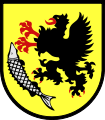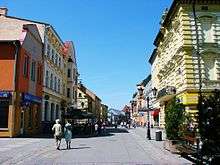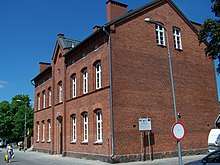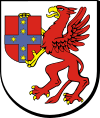Szczecinek
Szczecinek (Polish pronunciation: [ʂt͡ʂɛˈt͡ɕinɛk] Shche-tsee-nek; German: Neustettin; Kashubian: Nowé Sztetëno) is a historic city in Middle Pomerania, northwestern Poland, with a population of more than 40,000 (2011). Formerly in the Koszalin Voivodeship (1950–1998), it has been the capital of Szczecinek County in the West Pomeranian Voivodeship since 1999. It is also known as Krono-Zdrój or Kronobyl. It is an important railroad junction, located along the main Poznań - Kolobrzeg line, which crosses less important lines to Chojnice and Słupsk. The city boundaries were expanded in 2009 to include the surrounding villages of Świątki and Trzesieka, a total area of 48.63 square kilometres (18.78 square miles).
Szczecinek | |
|---|---|
Panorama of the town | |
 Flag  Coat of arms | |
 Szczecinek | |
| Coordinates: 53°43′N 16°41′E | |
| Country | |
| Voivodeship | West Pomeranian |
| County | Szczecinek County |
| Gmina | Szczecinek (urban gmina) |
| Established | 1310 |
| City rights | 1310 |
| Government | |
| • Mayor | Daniel Rak |
| Area | |
| • Total | 48.63 km2 (18.78 sq mi) |
| Population (2010) | |
| • Total | 40,211 |
| • Density | 830/km2 (2,100/sq mi) |
| Time zone | UTC+1 (CET) |
| • Summer (DST) | UTC+2 (CEST) |
| Postal codes | 78-400, 78-401, 78-402, 78-403, 78-404, 78-410 |
| Area code(s) | +48 94 |
| Car plates | ZSZ |
| Website | http://www.szczecinek.pl |
The turbulent history of Szczecinek reaches back to the High Middle Ages, when the area was ruled by Pomeranian dukes and princes. The majority of the city's architecture survived World War II and, subsequently, its entire Old Town was proclaimed a national heritage monument of Poland.
Location
Szczecinek lies in eastern part of West Pomeranian Voivodeship. Historically, it was included within Western Pomerania. In 2010, the city boundaries were expanded as the town merged with the following villages in Gmina Szczecinek: Gałowo, Marcelin, Godzimierz, Turowo, Parsęcko, Buczek and Żółtnica.
History and etymology
.jpg)

In the Middle Ages a Slavic stronghold existed in present-day Szczecinek.[1] It was part of the early Polish state in the 10th century, and as a result of the 12th-century fragmentation of Poland, it became part of the separate Duchy of Pomerania.
In 1310, the castle at the site of a former stronghold, and town were founded under Lübeck law by Duke Wartislaw IV of Pomerania and modelled after Szczecin (German: Stettin) which is situated about 150 kilometres (93 miles) to the west. The initial name was "Neustettin" (Polish: Nowy Szczecin, German: Neustettin, Latin: Stetin Nova). It was also known as "Klein Stettin" (Polish: Mały Szczecin, German: Klein Stettin). In 1707 the town was known in Polish as Nowoszczecin, while the Mały Szczecin name gradually developed into the modern name Szczecinek.[2]
The town was fortified to face the Brandenburgers, with a wall and palisades. In 1356 it was hit by the plague. Thankful for their survival, the Dukes Bogislaw V, Barnim IV and Wartislaw V founded the Augustine monastery Marientron, on the Marientron hill on the southern bank of the Trzesiecko Lake. It was plundered by Brandenburgers in 1470. From 1368 to 1390 it was the seat of an eponymous duchy under its only historic ruler Wartislaw V. Afterwards, it was ruled by Pomeranian duchies: Darłowo (Rügenwalde) (-1418), Wolgast (-1474) and the united Duchy of Pomerania (until 1618).
On 15 September 1423, the "great day of Neustettin", the Pomeranian dukes, the Grand Master of the Teutonic Order and Nordic king Eric VII of Denmark, Norway and Sweden met to discuss defense against the union of Brandenburg and Poland. During the Thirteen Years' War, local dukes changed alliances several times. As a result, in 1455 several surrounding villages were looted by Teutonic Knights and in 1461 the town was sacked, looted and burned by Polish troops and Tatars because King Casimir IV Jagiellon wanted to take revenge on Eric II of Pomerania who supported the Teutonic Knights.[3]
In 1601 a Polish school was established, and in 1640 a gymnasium was founded, which as today's I Liceum Ogólnokształcące is one of the oldest high schools in Pomerania.[4] During the Thirty Years' War it was captured and plundered by the Swedes and Austrians. After the war, from 1653, the town was part of Brandenburg, from 1701 of Prussia and from 1871 to 1945 of Germany. During the Seven Years' War, in 1759 it was plundered by the Russians. In 1807, during the Napoleonic Wars and Polish national liberation fights, the town was captured by Poles led by Tomasz Łubieński.[3]
In 1881 Abraham Springer, great-grandfather of TV presenter Jerry Springer and a prominent member of the town's Jewish community launched an unsuccessful attempt to sue agitator Dr Ernst Henrici, claiming that an inflammatory anti-semitic speech in the town led directly to the burning down of the synagogue on 18 February of that year.
In 1914 the Regional Museum was established. In 1923 the Catholic Church of the Holy Spirit was built, then called the "Polish Church", as it was co-financed by local Poles.[5]
After the Nazis took power in Germany in the 1930s, new military barracks were built, and the invasion of Poland was carried out from the town at the beginning of World War II in 1939.[3] In September 1944, the Germans made the first arrests of local members of the Polish underground organization "Odra", ultimately crushing it in the following weeks. The town was captured by the Red Army in February 1945,[3] and put under Polish administration. The town's German population was expelled, and it was repopulated with Poles, expellees from former eastern Poland annexed by the Soviet Union and settlers from central Poland.[3]


Education
- Duchess Elizabeth Secondary School
- Vocational School of Economics in Szczecinek
- Vocational Technical School in Szczecinek
- Vocational School of Agriculture in Świątki
- Private Secondary School
- Social Secondary School
- Społeczna Wyższa Szkoła Przedsiębiorczości i Zarządzania in Łódź, branch in Szczecinek
- Koszalin University of Technology, branch in Szczecinek
Major corporations
- Grupa Kronospan Szczecinek
- KPPD Szczecinek SA
- Schneider Electric Poland
Historical population
- 1940: 19,900 inhabitants (mostly Germans)
- 1945: 11,800 inhabitants (8,300 Poles and 3,500 Germans)
- 1950: 15,100 inhabitants (mostly Poles)
- 1960: 22,800 inhabitants
- 1970: 28,700 inhabitants
- 1975: 32,900 inhabitants
- 1980: 35,700 inhabitants
- 1990: 41,400 inhabitants
- 1995: 42,300 inhabitants
- 2000: 38,928 inhabitants
- 2017: 40,292 inhabitants
Notable residents

- Caspar Otto von Glasenapp (1664 at Gut Wurchow – 1747), Prussian Generalfeldmarschall
- Franz Albert Schultz (1692–1763), Prussian divine and ecclesiastical superintendent.
- Friedrich Jacob Behrend (1803–1889), German physician, published works on venereal disease, public hygiene and prostitution
- General Friedrich Kasiski (1805–1881), German infantry officer, cryptographer and archeologist
- Lothar Bucher (1817–1892), German publicist and trusted aide of Otto von Bismarck [6]
- Gustav Behrend (1847–1925), German dermatologist
- Hans Krüger (1902–1971), politician, stepped down from his role amid controversy about his WWII background
- Eckart Afheldt (1921–1999), general
- Horst Mann (1927–2018), German sprinter, competed at the 1956 Summer Olympics
- Aleksander Wolszczan (born 1946), Polish astronomer, co-discovered the first extrasolar planets and pulsar planets
- Wiesław Adamski (1947–2017), Polish sculptor
- Jolanta Danielak (born 1955), Polish politician, served in the national Senate from 1997 to 2005
- Jarosław Boberek (born 1963), Polish film actor and voice actor
- Ewa Minge (born 1967), Polish fashion designer
- Dorota Dziekiewicz-Pilich (born 1969), Polish sculptor and drawing artist
- Artur Bugaj (born 1970), footballer
- Paweł Małaszyński (born 1975), Polish actor
- Aleksandra Gintrowska (born March 28, 1991), Polish singer and actress.
International relations
Szczecinek is twinned with:
References
- Czesław Piskorski, Pomorze Zachodnie, mały przewodnik, Wydawnictwo Sport i Turystyka, Warszawa, 1980, p. 261 (in Polish)
- "Historia i zabytki". Oficjalna strona Urzędu Miasta Szczecinek (in Polish). Retrieved 11 February 2020.
- "K.Berezowski: Plan lekcji z 1705 roku! Szkoła liczyła 11 uczniów..." Szczecinek.com (in Polish). Retrieved 11 February 2020.
- "Historia parafii". Parafia Ducha Świętego w Szczecinku (in Polish). Retrieved 11 February 2020.
- . Encyclopædia Britannica. 04 (11th ed.). 1911.

.jpg)
